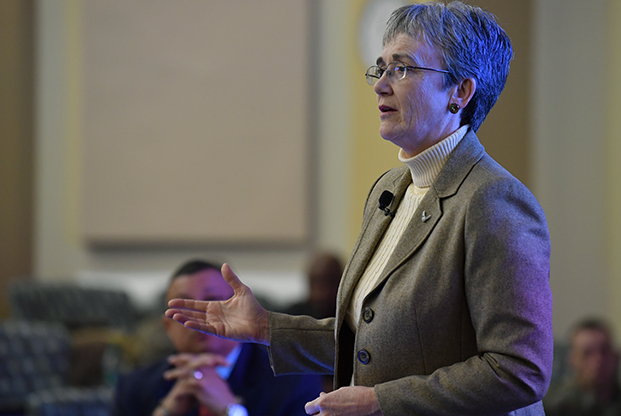
Air Force Secretary Heather Wilson, shown here during a the Command Chief Master Sergeant training course at JB Andrews, Md., on Jan. 15, 2019, said the service's plan for its bomber fleet "has not changed" since the command put out an executive summary of its “Bomber Vector,” or roadmap, just over a year ago. Air Force photo by Wayne Clark.
Air Force Secretary Heather Wilson says Global Strike Command’s proposal to retire the B-1 and B-2 bombers as B-21s enter the force — while retaining the B-52 — remains the service’s plan for its bomber fleet.
“That plan has not changed” since the command put out an executive summary of its “Bomber Vector,” or roadmap, just more than a year ago, Wilson said in a recent interview in her Pentagon office. The Air Force subsequently published its “Air Force We Need” study, which called for an additional seven bomber squadrons, leading many to speculate that the service might retain the two younger of its three bomber fleets after all.
“We need a minimum of 175 bombers, is what we announced last year,” Wilson said, “and that they will be a mix of B-21s and B-52s. We’re continuing to put money into the modernization of the B-52; re-engining and other kinds of systems, so we’ll be driving that forward.”
The Bomber Vector said that if the bomber enterprise is to live within manpower and funding constraints expected in the coming decade, it can only have two types of bombers in the fleet. Given that the B-52 is versatile, is the only cruise-missile-launching platform of the three, and has a better maintenance record than the B-1 and B-2, Global Strike Command said it would retain the 67-year old B-52s and divest the more expensive B-1 and B-2 in the 2030-32 timeframe.
The B-1s and B-2s would be replaced by the B-21, and Wilson said she’s pleased with the progress of that program.
“It’s on schedule at the moment, and we had the Critical Design Review. We think the program is being well-run at this point, so there’s no change to the schedule,” she noted. She added that the B-21 is “one of our best-managed programs.”
Wilson acknowledged the push for more bombers in the “Air Force We Need” construct and said “the stress on the force is in the ability to have long-range strike … the need for more bombers and tankers.” Air Force plans call for “at least” 100 B-21 bombers, but added to the B-52s, that only translates to a fleet of about 175 aircraft.
AFA’s Mitchell Institute recently published a paper asserting that the long-range strike requirements of the Air Force are probably around 270 aircraft, given the distances in the Pacific, the threat from Chinese long-range precision missiles to USAF island bases, and the extended range of air defense systems worldwide. The Mitchell Institute suggested that the B-1 and B-2 should not be retired until an equally robust force of B-21s is operational.